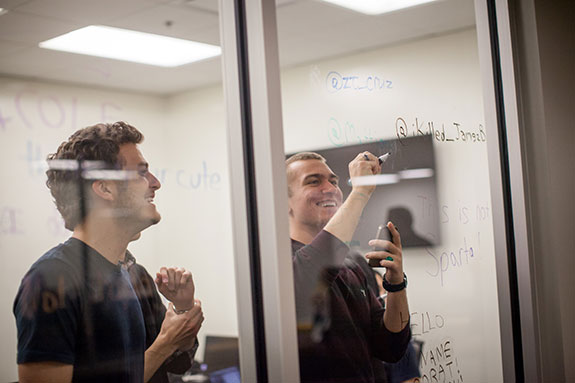Source - fueled.com




Do you have a great idea for an app?
With the app ecosystem thriving, it’s an ideal time to transition your vision for an app into a reality. With a plan and guide, even an inexperienced entrepreneur or individual without coding capabilities can successfully produce an app.
We asked Fueled Strategist Perry Curac-Dahl to break down the process of building an app into four phases.
These four steps will take an app all the way from an idea to an in-market product, or Minimum Viable Product that is ready to be reviewed and improved.

What is a Minimum Viable Product (MVP)?
An MVP is the early version of an app or product that is developed only with the necessary and sufficient features to satisfy the early user. Typically, once feedback is received from users of the MVP, an app will be developed and designed with a more complete set of features. This guide will take you through the process of taking your idea for an app and turning it into an MVP.
PHASE ONE: IDENTIFY THE PROBLEM

Before enlisting the help of an app development agency, Curac-Dahl recommends taking the time to identify and hone in on “the underlying problem” that you want your app to mitigate. At this point, you don’t need to worry about the specific elements of your app such as its minor design details, but you should be strongly focusing on the issue that your app is here to fix. To succeed, your app needs to solve a problem or hold a value to the user, and a truly successful app will manage to do both. You want to focus on the problem, so don’t immediately jump into trying to determine the solution.
What if another app seems to deal with the same problem that yours aims to?
“Don’t let competition deter you,” says Curac-Dahl. “Competition shows that there is a market there” for your product and if your idea for an app is a good one, odds are that “multiple people are going to have the same idea.” Think about it: Seamless, DoorDash, Caviar and plenty of other companies offer restaurant food delivery. If you come across apps that seem to solve the problem that yours aims to, consider what will distinguish yours from competitors while still targeting the audience that is proven to exist by your competition.
Instead of worrying that you are too late with your idea, consider the benefits of second mover advantage. Moreover, by following similar products into the market, you can learn from their successes and failures to adapt your own app based on your findings.
PHASE TWO: DETERMINE A SOLUTION

Once you have clearly defined the problem that your app will aim to solve, it’s time to begin formulating your solution. The first version of your product can’t possibly be anything more than a guess and at best, it will be an educated one. Only once it is out on the market can you receive external feedback that will be telling of its capabilities.
In order to present an educated guess in this first version, enlisting the help of experts is a must. Curac-Dahl recommends coming to a place like Fueled: “We have experts in the space who can help you develop an ideal first solution.” If you can afford it, working with an app development agency will provide you with expert insight and experience.
PHASE THREE: BUILD THE FIRST VERSION OF YOUR APP

Now that you have a clear idea of the problem and the solution you intend to offer, it’s time to build the first version of your app and get it to market quickly. It’s extremely important at this point to build and launch a Minimum Viable Product that is high quality. With over one million apps available in the App Store and in Google Play, competition is high and low-quality apps with a substandard user experience won’t succeed.
Create a Feature Set:
Whether you are building your app yourself, with your own team, or with a development agency, you should create a feature set. A feature set is a written document that details the specifications of an app, including the design of the product and a description of the technologies needed for the project. A feature set will make it easier to communicate your product vision with team members, developers, and investors, and it will serve as a reference throughout the process of building the app. Additionally, the exercise of creating a feature set will help you to define and narrow your product.
Create a wireframe:
A wireframe is basically a blueprint or basic framework of the screens that will be included in your app. The easiest and quickest way to create a wireframe is by using pen and paper. At this point, you can begin imagining the physical features of your app. Try to draw out each screen of your product from start to end, and think about the experience you want your users to have when using it. While going through this exercise of creating a basic wireframe, remember to focus on your defined product and don’t get carried away envisioning unnecessary elements.
Your feature set should include:
- An introduction to your product
- The vision for your app in terms of the product, design, and business
- A detailed description of the technical features of your app and each page of your app
Now it’s time to talk about coding.
TO CODE YOURSELF OR TO OUTSOURCE?
When it comes to coding an app, you have three options: you can either hire an app development agency to build and design your product, you can create your own internal design and development team, or you can build the app yourself.
If you can afford it, hiring an app development agency to build your app is your best bet. Because of their experience, a reputable development shop will likely deliver a high-quality app in a short period of time. If built by a well-regarded shop, your app will be worked on by a team of individuals, each of whom is an expert in his or her own field. These development and design experts are likely to have a good grasp on the ever-changing landscape of app competition and Apple Store acceptance, and they will use this knowledge to your app’s advantage throughout the development process. Here’s more on the price of developing an app.
Putting together a team of designers and developers is another way to approach building your app. While there are definite upsides to keeping development internal, the process of building a team is often time-consuming and expensive. Curac-Dahl warns that unlike the well-oiled machine of agencies, there is no guarantee that a team you have put together yourself “will work well together.”
It’s also possible to develop a first version app on your own. However, doing so requires having full stack developing capabilities (the ability to do both front-end and back-end development) – not to mention, a lot of time. Moreover, Curac-Dahl comments, “If any of these factors aren’t in existence, it’s beneficial to hire someone.”
PHASE FOUR: REVIEW AND REBUILD WITH MARKET FEEDBACK
Whether you’ve built your app yourself or have hired an agency to help you, once you are satisfied with your product, you can release it to the market. Although this is the fourth phase, you are still at a very early stage of the process to making a successful app. Only once your app is out will you be able to see its positive features and shortcomings, and only at this point can your product evolve and improve with feedback and input from the market.